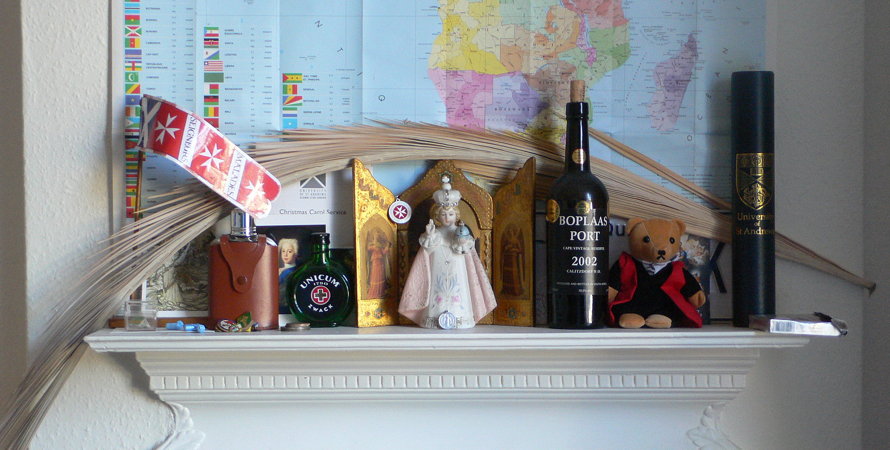

About Andrew Cusack
 Writer, web designer, etc.; born in New York; educated in Argentina, Scotland, and South Africa; now based in London.
Writer, web designer, etc.; born in New York; educated in Argentina, Scotland, and South Africa; now based in London. read more
News
Blogs
Reviews & Periodicals
Arts & Design
World
France
Mitteleuropa
Knickerbockers
Argentina
The Levant
Africa
Cape of Good Hope
Netherlands
Scandinavia
Québec
India
Muscovy
Germany
Academica

A Mantelpiece
ONE MUST ALWAYS have a mantelpiece. That, at any rate, is my considered opinion. It is a focal point where one can place random objects of vague significance upon it as a salutary reminder of the varied importance of the numerous sectors of one’s life and the gentle interplay therebetween. In my admittedly brief (yet increasingly less brief) existence, I have had several mantelpieces. Indeed, I was even for a year at university in possession of a listed mantelpiece though, sadly, it was abused by the presence of an interloping non-functioning electric heater. But my current riparian London residence is augmented by a number of mantelpieces, one of which fortuitously sits in my own bedroom. While I generally prefer to leave things unexplained, here is a little guide to my mantel as it now stands.
Behind the entire tableaux hangs a French map of Africa I picked up during the summer I lived in Oxford. The recent independence of South Sudan renders it inaccurate, in addition to two or three vexillological changes in its corner display of flags. From left to right, we have the pennon of the Order of Malta in Scotland; the piece of the Berlin Wall my kindergarten teacher brought back from Germany for me; a Rackham postcard from Don Riccardo illustrating depicting a scene from Baron Foqué’s Undine (“Soon she was lost to sight in the Danube”), to which Don Riccardo has added the cryptic line “The fate, it seems, of all Cusack’s loves”.
Next is the glass flask with leather covering I picked up at an antiques place in Millbrook when wandering around hunt country with the Gills; a postcard of Bonnie Prince Charlie sent by the Cap’t as a thank-you note for hosting lunch at Rocca with our favourite ancient veteran of King’s African Rifles; the order of service from the University of St Andrews Alumni Club London carol service; a small bottle of Unicum brought back from Hungary by E.W.; a Marian prayer card from Tom & Alice; a little unpretentious triptych some relative bought; my Order of Malta Lourdes pilgrimage medal; an Infant of Prague retrieved from my grandparents’ house; a St Benedict medal (perhaps obtained at Downside).
The bottle of Boplaas Port was kindly (and perhaps unintentionally) left by one of the previous South African residents of our flat. It was finished off by our Continental correspondent Alexander Shaw and I late one night when he had just alighted the Eurostar and not yet had time to drop his bags off at his grandmother’s place a few minutes up the river on Chiswick Mall. Cornelius Bear is dressed in the red gown of a St Andrews undergraduate. Behind him is a Quebec automobile numberplate and a prayer card from St Philip’s Day 2012 at the Oratory. My Magister Artium diploma is rolled up in its tube next to an empty box of Dunhills purchased in Milan — “Il fumo invecchia la pelle” it warns. Surmounting all is a palm from Palm Sunday at the Oratory.
Search
Instagram: @andcusack
Click here for my Instagram photos.Most Recent Posts
- In the Courts of the Lord February 13, 2025
- American Exuberant February 10, 2025
- Crux Alba Journal Launch February 10, 2025
- The Year in Film: 2024 February 10, 2025
- Articles of Note: 27 January 2025 January 27, 2025
Most Recent Comments
- on When an American aristocrat meets a European Grand Duke
- on The Year in Film: 2024
- on Jesuit Gothic
- on The Borough Synagogue
- on No. 82, Eaton Square
- on Christ Church
- on The Last Will and Testament of Louis XVI
- on Amsterdam
- on Season’s Greetings from the Seventh
- on Season’s Greetings from the Seventh
Book Wishlist
Monthly Archives
Categories



Scandal! Chimneypiece, darrrrrling! Chimneypiece.
Just to be precise the Infant of Prague was my mother’s statue not from the Cusack grandparents. The triptych was Grandma Cusack’s. Very equal representation I’d say.
Hoerah!
You have finally posted! Phew, thanks!
And I agree with you wholeheartedly, a mantelpiece is, indeed, required. Alas, I live in a Neo-Gothic ‘atelier’ and there is no chimney, only a ‘kachel’ that has a great hunger for expensive oak corde-de-bois every winter and spring. But rather that than fork out to the evil energy company.
The Infant of Prague reminds me of that forlorn Infant of Prague Mission outside of Bridgeport in the back of beyond of the California-Nevada border region behind Yosemite north, of Mono Lake.
Groete …
We, inhabitants of l’Isle de France, never had much use of such an artefact, though, those amongst us most mindful of the ancient ways always insist on having a primitive hearth in the outer kitchen, as did our ancestors. Sadly, very few now have outer kitchens specially consecrated to the preparation of all manners of meats, especially game, which was hung over the hearth.
Nice collection. I am a bit surprised you acquired the map in England and not in your travels in Africa.